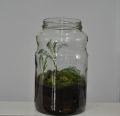Growing Plasmodia
The different Ideas of the Project
My Final Project
Concept
This section is devoted to those non-scientists (or fledgling scientists) who are interested in simple methods for culturing Physarum. Some of the documentation included here is not easily referenced, having come from websites that are no longer available, or having been obtained via web-surfing (e.g. Google) that yielded material in one search but not another. Wherever possible I have included, in the document, the URL from which it was obtained and/or an acknowledgment of the source. I apologize for any inadvertent infringement on copyright or "intellectual property" but ask forgiveness since the sole purpose of this section is to encourage the non-expert - especially young students - to give it a try and HAVE SOME FUN.
Process
In this part I would like to show the process of a project from the beginning to the end.
- Life Cycle of Physarum polycephalum [1]
- A Simple Method of Growing the Plasmodial Slime Mold Physarum Polycephalum [2]
- Growing Plasmodia [3]
Materials
- Petri dish (glass or plastic, need not be sterile) or other suitable container.
- Paper towels (white is best, brown will work).
- Old Fashioned Oatmeal Flakes (not the instant).
- Tap water.
- A plasmodium or sclerotium-available from biological supply houses.
- Medium
- 100 ml of distilled water
- 2g of agar
- oat flakes
Methods
Cover container bottom with piece of paper towel.
- Place piece of living plasmodium or sclerotium on paper towel.
- Moisten paper towel with tap water and drain off excess water.
- Add one oat flake near slime mold.
- Place lid over dish and place in a dark place at room temperature (e.g. place in a drawer or closet).
- Next day examine culture and sprinkle with water to give Physarum a gentle rinse and pour off excess water (rinsing improves growth). *Add 1-3 additional oat flakes near advancing front of plasmodium.
- Continue to examine, rinse, and feed daily or every few days.
Additional cultures are easily made by transferring a plasmodial covered oat flake to another container. Producing several cultures is desirable to ensure that you don't loose an only culture due to a unforeseen failure of a plasmodium. Also, having more than one culture allows you to test the effects of different treatments on the slime mold (e.g. exposure to light, cold, different food sources, etc.).
Final Project
Now you can see the photos of final project.
Refrences
here are the references of a project this semester. [4]



















